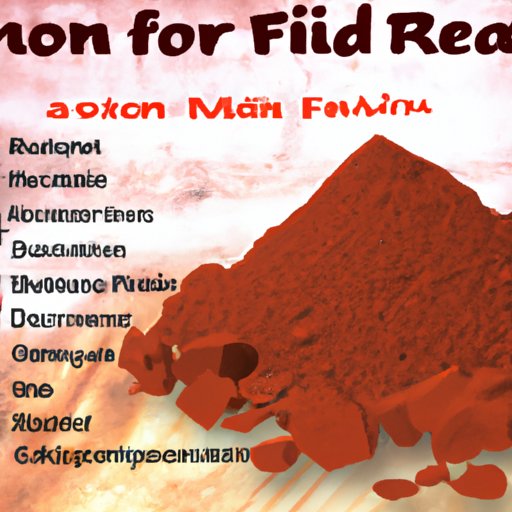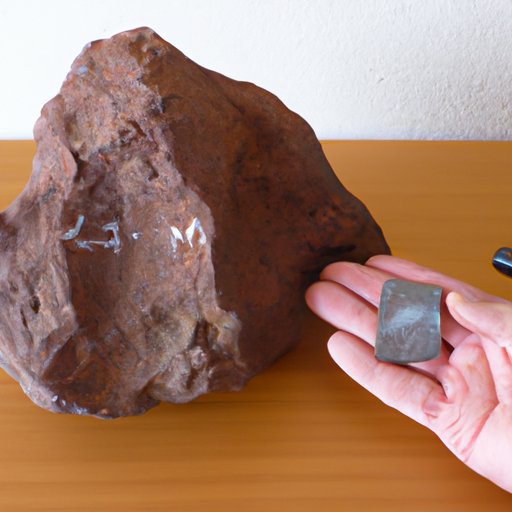Introduction
Trace minerals are essential for many bodily functions, including growth, development, metabolism, and immunity. Iron is one of these trace minerals, and it plays an important role in human nutrition and health. In this article, we’ll explore the role of iron as a trace mineral, its importance in the body, potential benefits and risks, and how to get enough of it.

Exploring the Role of Iron as a Trace Mineral in Human Nutrition
Iron is an essential trace mineral that plays an important role in human nutrition. It helps carry oxygen in the blood, support energy levels, and maintain a healthy immune system. Without enough iron, a person can experience anemia, fatigue, and weakened immunity.
How does iron work in the body? The body absorbs iron from food and breaks it down into two types: heme and non-heme. Heme iron comes from animal sources, such as red meat and poultry, while non-heme iron is found in plant-sources, such as legumes, nuts, and fortified cereals. Once absorbed, the body stores iron in the liver, spleen, and bone marrow, where it binds to a protein called transferrin. Transferrin then transports iron to other parts of the body, such as the brain, muscles, and organs.
What happens when a person lacks enough iron? Iron deficiency anemia is the most common type of anemia, and it occurs when the body has too little iron. Symptoms include fatigue, pale skin, shortness of breath, and dizziness. Iron deficiency anemia can also lead to impaired cognitive development in children and an increased risk of infection.

The Benefits and Risks of Iron as a Trace Mineral
Iron has many potential benefits for overall health. For example, it plays a role in the production of hemoglobin, which transports oxygen throughout the body. It also helps convert food into energy, and it supports a healthy immune system. Iron also helps reduce the risk of premature birth and low birth weight in pregnant women.
However, taking too much iron can be dangerous. Too much iron can cause iron overload, which can damage the liver, heart, pancreas, and other organs. Iron overload is especially dangerous for those with genetic disorders, such as hemochromatosis. People with this disorder absorb too much iron from food, which can lead to organ damage.

How to Get Enough Iron as a Trace Mineral
Adults should aim for 8-18 milligrams (mg) of iron per day, depending on age and gender. Women of childbearing age need more iron than men, due to monthly blood loss during menstruation. Pregnant women need even more—27 mg per day.
The best way to get enough iron is through dietary sources. Animal products, such as red meat, poultry, and seafood, are good sources of heme iron. Plant-based sources, such as legumes, nuts, and fortified cereals, are good sources of non-heme iron. Eating iron-rich foods along with foods high in vitamin C, such as citrus fruits and leafy greens, can help increase iron absorption.
If dietary sources aren’t enough, iron supplements can help. Iron supplements come in different forms, such as tablets, capsules, and liquid drops. Talk to your doctor before taking any iron supplements, as they can interact with certain medications and cause side effects.
What Foods Contain Iron as a Trace Mineral?
Iron is found in both animal and plant-based foods. Animal products, such as red meat, poultry, and seafood, are good sources of heme iron. Plant-based sources, such as legumes, nuts, and fortified cereals, are good sources of non-heme iron. Other good sources of iron include eggs, dark leafy greens, whole grains, and fortified breakfast cereals.
Understanding the Difference Between Iron and Other Trace Minerals
Iron is just one of many trace minerals that play an important role in human nutrition and health. Other trace minerals include zinc, copper, selenium, iodine, and manganese. While these minerals all play different roles in the body, they do have some similarities. For example, all trace minerals are essential for proper growth and development, and they’re all needed in small amounts.
It’s important to understand the difference between iron and other trace minerals because each mineral plays a unique role in the body. Iron helps transport oxygen in the blood, while zinc helps support immune function and copper helps form red blood cells. Taking too much or too little of any trace mineral can lead to health problems, so it’s important to get the right balance.
Conclusion
In conclusion, iron is an essential trace mineral that plays an important role in human nutrition and health. It helps carry oxygen in the blood, support energy levels, and maintain a healthy immune system. Getting enough iron is important for overall health, but taking too much can be dangerous. The best way to get enough iron is through dietary sources, such as red meat, poultry, seafood, legumes, nuts, and fortified cereals. Supplements may also be used, but only under the guidance of a healthcare professional.
(Note: Is this article not meeting your expectations? Do you have knowledge or insights to share? Unlock new opportunities and expand your reach by joining our authors team. Click Registration to join us and share your expertise with our readers.)
